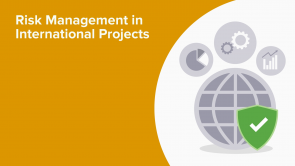Applying RM in ongoing Projects

About the Lecture
The lecture Applying RM in ongoing Projects by Simone Hoferer is from the course Risk Management (RM): Project Stage. It contains the following chapters:
- Objectives
- Risk management process
- Measurability of success
- Risk management during quoting stage
- The key method
- Project parties
- Risk categories
- SMART
Included Quiz Questions
Which is the correct process from inquiry to order?
- Definition/offer, planning/engineering, production/sourcing, transport/logistics, installation/launching, delivery/handover, warranty
- Definition/offer, planning/engineering, production/sourcing, transport/logistics, installation/launching, communication, warranty
- Definition/offer, planning/engineering, production/sourcing, warranty, transport/logistics, contract, delivery/handover
- Definition/offer, planning/engineering, production/sourcing, transport/logistics, installation/launching, warranty
Risk management can be compared to a sailboat. Why?
- It is important to prepare in advance.
- You have to look out for dangers as well as chances.
- You need to put your route into practice.
- You should identify your friends and foes.
- It is like a hobby and should be treated that way.
Why is the success of risk management often hard to measure?
- Because the „What would have happened, if…“ is often very hard to grasp.
- Because in reality the success of a project in total is the only indicator whether all measures and actions combined worked out well or not.
- If you do a proper controlling, it is fairly easy to measure the success or failure of risk management.
- Because the success depends only on the risk manager.
What is the purpose of risk management in the quoting stage?
- To capture and pin point the potential project as precise as possible
- To identify risks & opportunities, asses them and incorporate them into the quote
- To enable best possible offer in order to get the assignment and to be able to pick the right projects
- To follow through the risk management process as precisely as possible
What is the key method of risk management?
- To ask the right questions, e.g. the 7 W-method
- To find the right answers, e.g. the triple A method
- To coordinate and to communicate risks
- To use as minimum resources as possible
What are typical risk categories/ areas to look out for risks and chances?
- Company, country, customer, supplier and project
- Corporation, country, customer, supplier and project
- Company, country, customer, supplier and project manager
- Company, country, customs, supplier and project
An offer should be SMART. What do the individual letters stand for?
- S = Specific, M = Measurable, A = Acceptable & Adequate, R = Realistic and T = Time-phased.
- S = Special, M = Measurable, A = Acceptable & Adequate, R = Realistic and T = Time-phased.
- S = Specific, M = Measurable, A = Acceptable & Adequate, R = Realistic and T = Tough
- S = Specific, M = Memorable, A = Acceptable & Adequate, R = Realistic and T = Time-phased.
A SMART-offer includes phrasing and composition. What does this mean for your offer?
- Use easy to understand language and be clear, specific and distinct.
- Phrase as short as possible and as detailed as necessary.
- Be complete and add explanatory drawings, pictures etc.
- Be legally and ethically correct and fair.
- Be idealistic with dates and costs.
Customer reviews
5,0 of 5 stars
| 5 Stars |
|
5 |
| 4 Stars |
|
0 |
| 3 Stars |
|
0 |
| 2 Stars |
|
0 |
| 1 Star |
|
0 |
Excerpts from the accompanying material
... Objective of chapter 3: To familiarize with the various ...
... engineering 3. production/sourcing, 6. delivery/handover, 1. definition/offer, 7. ...
... Management Process 40 Graphic 5: Simone Hoferer 04/2013 based on Roland Wanner ...
... Assessment: identification friend or foe? Action planning: working out of alternatives. Navigate & control: ...
... happend, if…“ is often very hard to grasp. Added value for the project due to RM in proportion to effort hard to quantify ...




